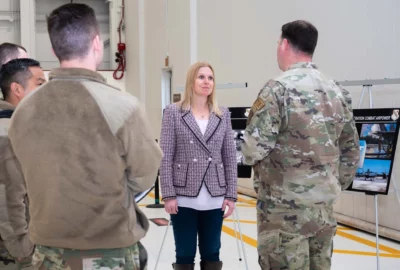Air Force begins phase 2 of enterprise IT service delivery
The Air Force released a new solicitation and plans to issue another one as part of its overall strategy to centralize many IT modernization efforts.
The Air Force is out with a new multiple award solicitation to modernize all of its base network infrastructure.
The request for proposals uses the phrase, “enterprise IT-as-a-service” only a handful of times, but for all intent and purposes, this potentially 10-year contract with a $12.5 billion ceiling is considered Wave 2.
The new RFP calls for a group of large and small businesses to “modernize, operate and maintain the network infrastructure on all Department of the Air Force locations, to include Guard and Reserve bases.”
The Air Force is planning to award at least five contracts to 8(a) firms as well as a minimum of three awards to HUBZone companies, women-owned small businesses, service-disabled veteran-owned small business firms and other small businesses not in a socioeconomic program.
“This effort takes lessons learned from the EITaaS risk reduction effort network-as-a-service effort as well as lessons learned from existing base IT infrastructure modernization efforts to modernize the future base area network (BAN) offering at Air Force bases worldwide,” the RFP states. “This effort intends to modernize the Non-Secure Internet Protocol Router (NIPR) and Secure Internet Protocol Router (SIPR) BAN through an as-a-service model utilizing contractor provided networking services.”
The Air Force says its goal through the BIM vehicle is to obtain standardized, innovative and agile IT services, increase integration through a modern streamlined network and to be an investment for future mission sets.
Air Force to reduce data centers
Winston Beauchamp, the deputy chief information officer at the Air Force, said the goal is to award the multiple award contract later this spring with the first set of task orders going out before the end of the fiscal year.
Beauchamp said the Wave 2 EITaaS RFP comes as the Wave 1 effort is picking up steam.
“They started by essentially absorbing the bases that were part of our risk reduction experiment originally, that preceded the acquisition, and they are right now delivering common central services that will be applicable to all bases,” Beauchamp said in an interview with Federal News Network after speaking at the AFCEA NOVA Space IT day. “We’re talking about things like a centralized helpdesk automation so that folks can do certain things on their own, like resetting passwords, and answering tier zero help desk type questions. Then also to come there’s field services. The option for folks to use our contract to put people in the field to support them at the bases of all that for centralized security and help desk services.”
The Air Force is using the base infrastructure modernization contract as a key piece to its centralization strategy. Beauchamp said not every IT service needs to be an enterprise service, but there are a wide variety of opportunities for the Air Force to improve how it delivers technology to its users.
For example, across the 185 Air Force and Space Force bases there are about 1,000 data centers running.
Beauchamp said the CIO’s office is making a big push to move applications to the cloud, where it makes sense.
“We fully expect that more and more applications will be moving into our cloud architecture. That’s called CloudOne today, and that contract is up for renewal. It will be re competed, and it will be calling it CloudOne Next, but the intent is that it will be just the next evolution of the CloudOne program,” he said. “The interface between that and the Joint Warfighting Cloud Capability (JWCC) our intent to leverage that contract to the maximum extent possible by buying cloud services capacity through JWCC, and then managing it under the CloudOne contract. The expectation is that we would continue to acquire cloud through JWCC, where it’s cost effective to do so in bulk and then we would provision it with security services that DevSecOps and the other layers of services that we’ve built up over the years on the under the CloudOne contract.”
Three cloud contracts in the works
The Air Force released its request for information for CloudOne Next in September and just in March, it offered more details on its acquisition strategy.
The Air Force expects to release three solicitations for CloudOne Next in the third quarter of 2024 and make the award in the fourth quarter of this year. It will be three single-award blanket purchase agreements on top of the schedules program run by the General Services Administration.
The three BPAs will focus on:
- Cloud service provider (CSP) reseller and software management
- Architecture and common shared services
- Enterprise application modernization and migration
Beauchamp said the Air Force is evolving from siloes of excellence where every system built its own technology stack to a series of enterprise capabilities where the burden to sustain, modernize and secure is shared.
“We really have is an opportunity to look at the degree to which there may be commonality between those approaches, either in factor or in potential, and where we can either use collective buying strategies to reduce the overall cost collective across the Air Force and collectively across DOD, to get the best possible deal through economies of scale,” he said. “If there’s an architectural approach that perhaps could leverage an existing enterprise service, we want to make sure that we have the ability to see them and to make those recommendations to really free up the time and resources so that those dollars can be applied towards more effective mission capability.”
This approach to IT portfolio management is one of the six lines of effort Air Force CIO Venice Goodwine outlined in her strategy.
Other lines of effort include the acceleration of cloud adoption, the future of cybersecurity, including zero trust, workforce development and training, software management and data and artificial intelligence.
Beauchamp said IT portfolio management, or line of effort 4, is one of the most exciting opportunities for the Air Force. He said IT portfolio management can create leverage across the entire department that can result in both savings and money redirected toward mission needs.
“Overall, I think that each of the sub objectives within line of effort four are going to contribute in some way in that direction. Everything from implementing a capital planning and investment control (CPIC) approach within the Department of Air Force, which we are piloting this year, to improving our monitoring of the user’s experience, which really enables us to target our modernization efforts on those areas where folks are suffering the most will allow us to make better use of the resources that we have for free enterprise IT,” he said. “One of the things we’re going to have to do is really reexamine how we’re implementing CPIC. When I say the pilot, what we’ve done is we’ve selected a major command and a couple of functional areas, where we’re going to put a more rigorous capability in place to really meet not just the letter of the law, but the spirit as well, and apply the data to actually make business decisions. That’s the key. If you if you’re going to go to the trouble of collecting all this data about your programs, you might as well use that data for informing your decision making.”
Copyright © 2025 Federal News Network. All rights reserved. This website is not intended for users located within the European Economic Area.
Jason Miller is executive editor of Federal News Network and directs news coverage on the people, policy and programs of the federal government.
Follow @jmillerWFED






